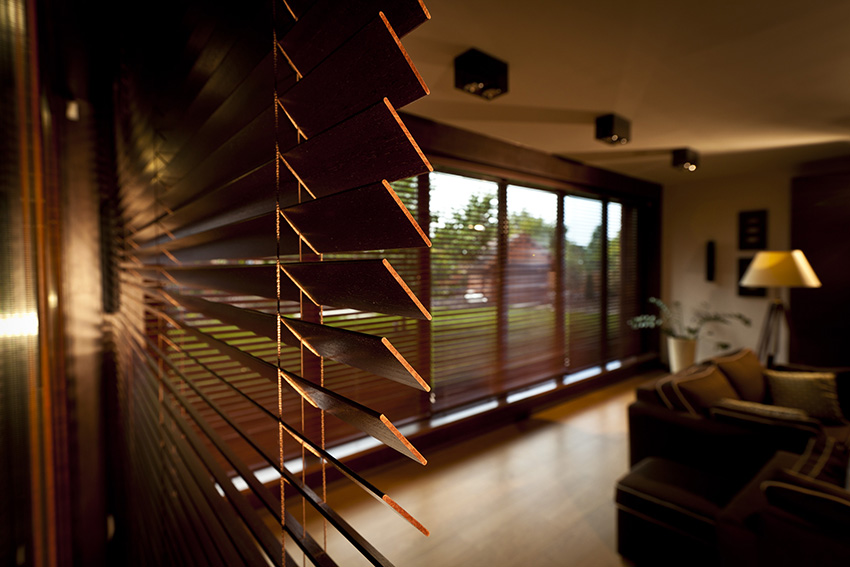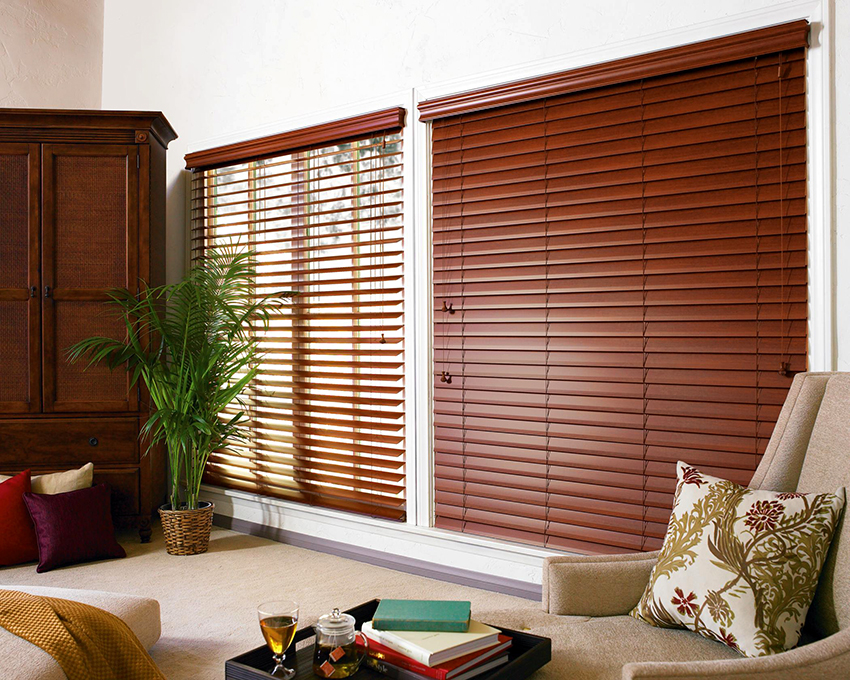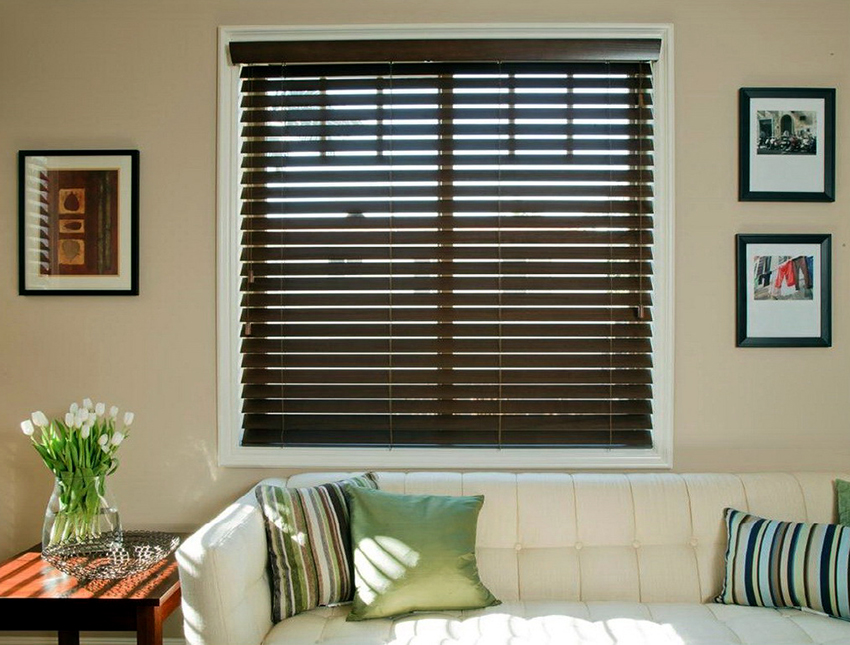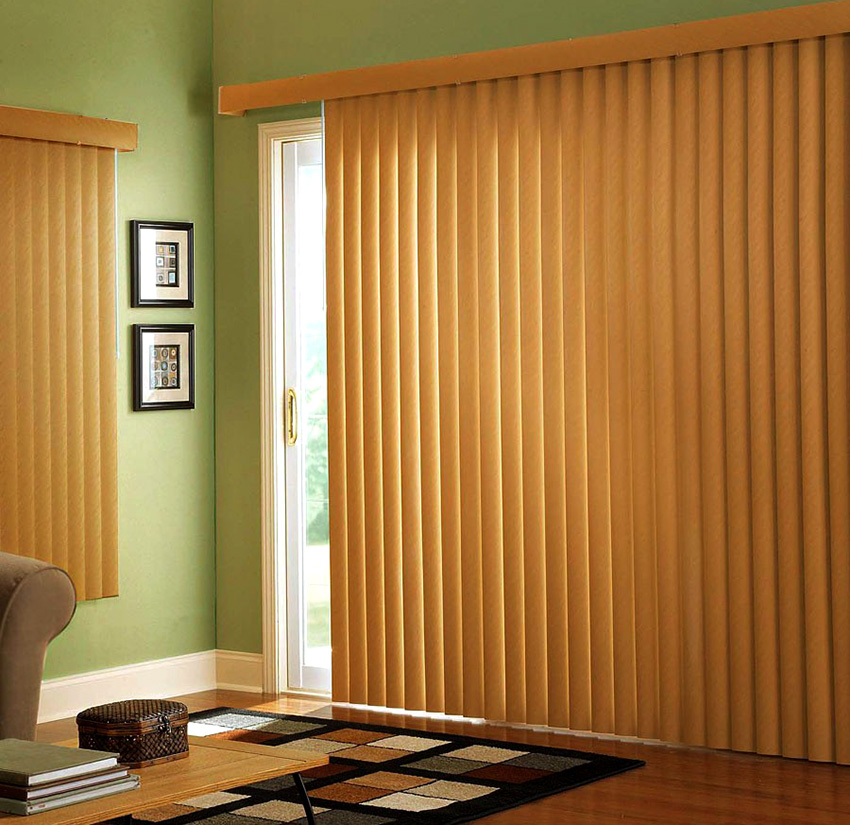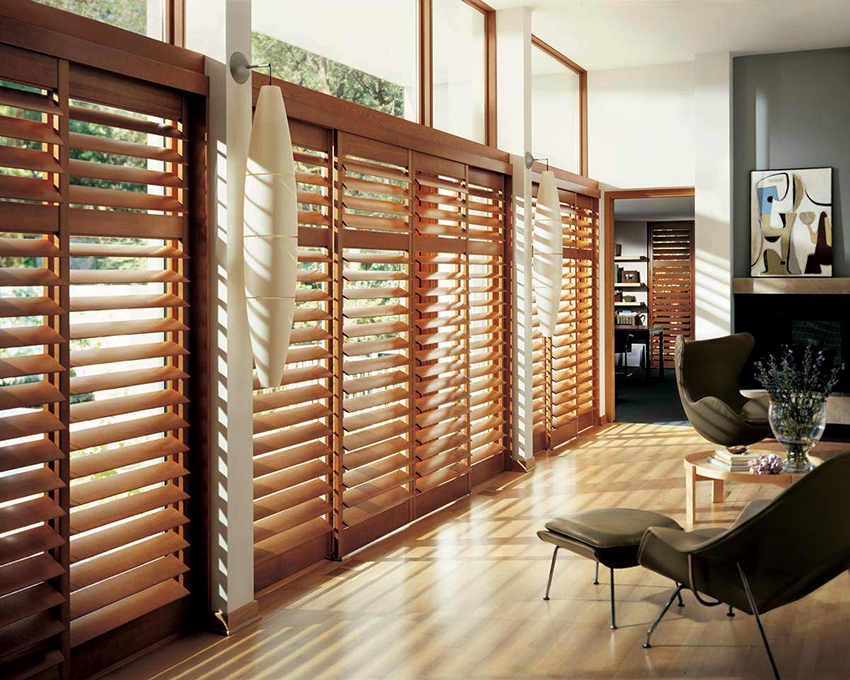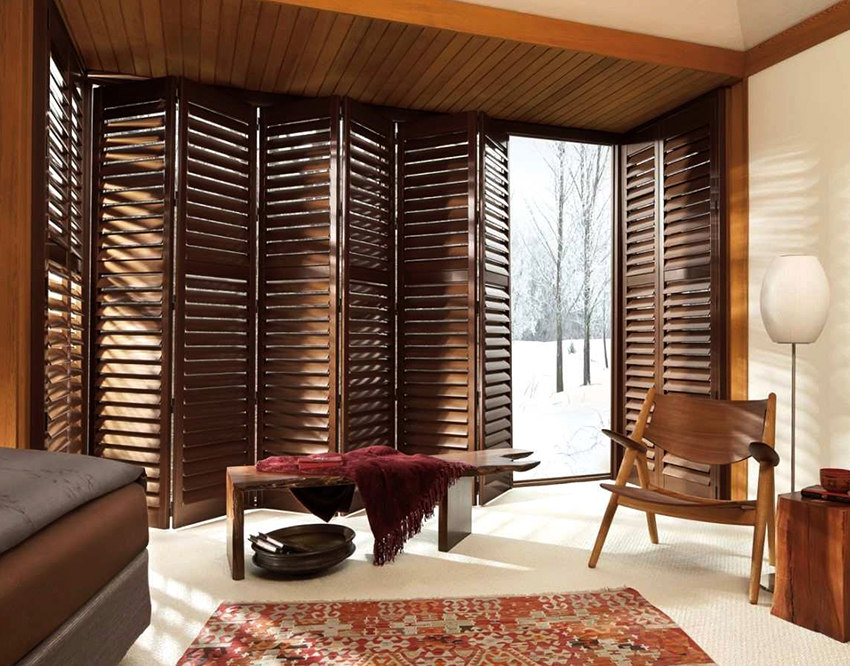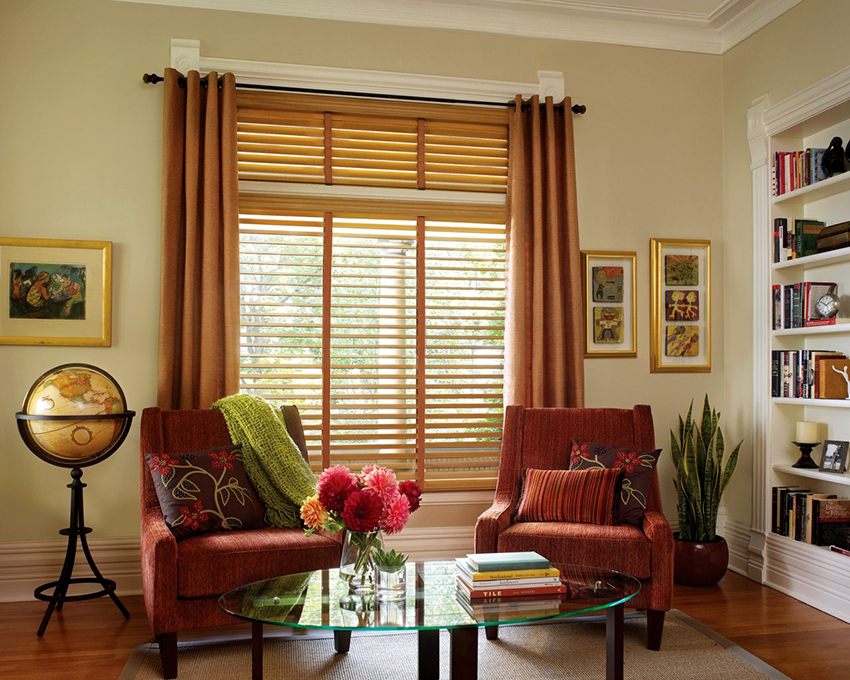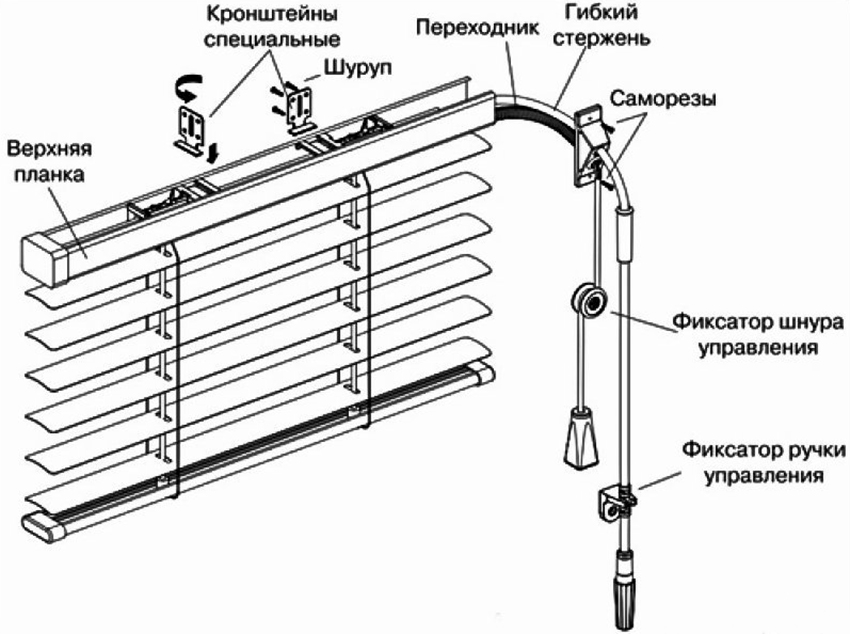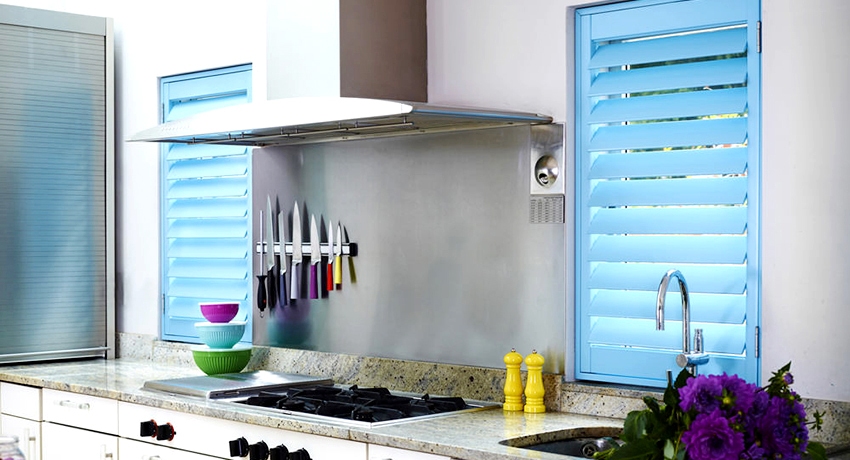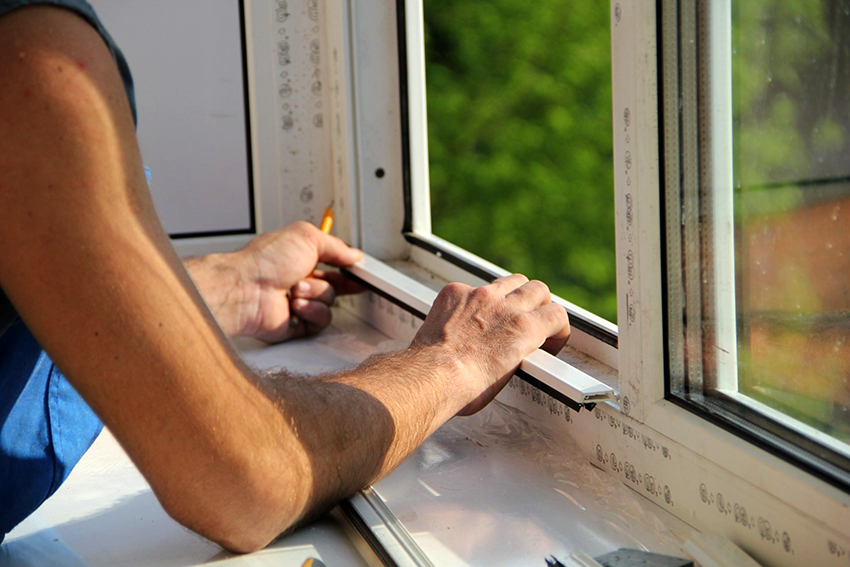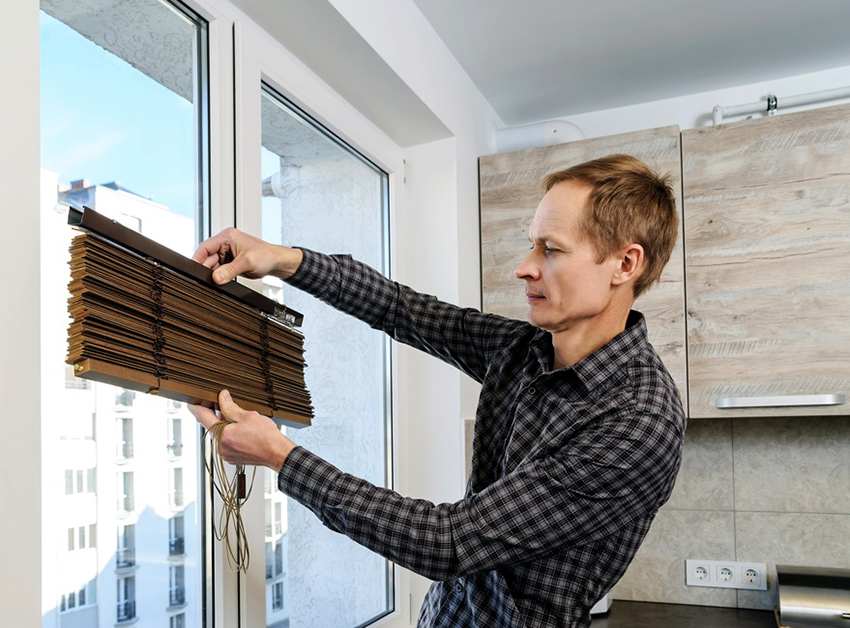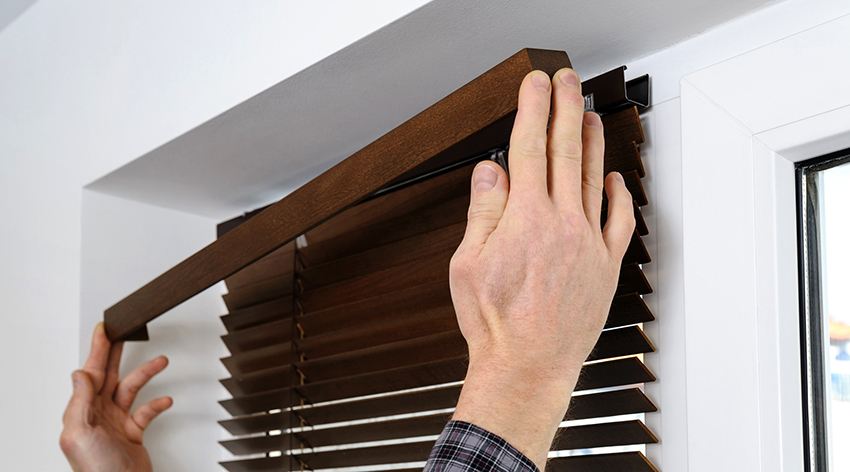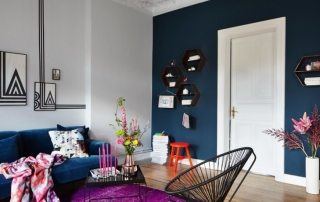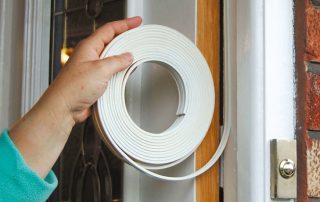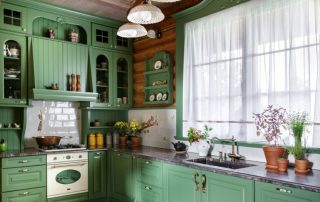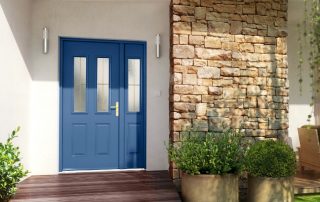When decorating modern interiors, many designers use wooden blinds for windows. These products contribute to the creation of a favorable microclimate in the room, at the same time being its decorative decoration. These are environmentally friendly, practical, functional and aesthetic curtains for windows that fit any interior design. What are the features of such blinds? Which type is better to choose? The answers to these and other questions are presented in the article.
Content [Hide]
- 1 Wooden blinds on windows: device and features of this type of curtains
- 2 The main advantages and disadvantages of wooden blinds for plastic windows
- 3 Vertical, roller blinds and horizontal blinds for windows
- 4 The use of blinds on windows: photos of interiors
- 5 Installation of blinds on plastic windows to the wall or ceiling
- 6 Performing blinds repair at home
- 7 DIY wooden blinds: instructions and materials for manufacturing
Wooden blinds on windows: device and features of this type of curtains
For the first time they started talking about wooden blinds several centuries ago, when the products were protective curtains that prevented the passage of sunlight into the room and closed them from prying eyes. Such a curtain was invented by a Venetian merchant, who thus tried to hide his wife from envious people.
Modern wooden blinds are thin slats held together with a strong rope or chain. The lamellas are made of durable beech, cherry, mahogany, linden, cedar or cork wood, which determines the price of wooden blinds for a window. The slats are made no more than 3 mm thick and 2.5-5 cm wide. Each option can be clearly seen in the catalogs of blinds from different manufacturers. From above, the elements are covered with a special non-toxic varnish that protects the material from external negative influences, moisture and dust.
The design can be supplemented with a remote control or a switch for automatic control, which increases the cost of blinds per window. Also, the set may include a system of weights for manual adjustment of the position of the blinds, decorative lacing, which hides the junction of the lamellas.
The main advantages and disadvantages of wooden blinds for plastic windows
Among the main advantages of wooden blinds are strength, durability, environmental friendliness and durability.Wood is a hypoallergenic material, therefore it does not have a negative effect on the human body. It is recommended to install such blinds in children's rooms and bedrooms.
These curtains fit perfectly into any interior design, making it original and stylish, as shown by photos of IKEA wooden blinds. The designs are distinguished by a wide variety of natural shades. Lamellas made of natural material reliably protect the room from the penetration of ultraviolet rays, while they do not fade or deform from excessive exposure to the sun.
The structure is easy to operate, which allows you to select the appropriate position of the slats to ensure the optimal intensity of natural light in the room. Wooden blinds do not need special care. To maintain the aesthetic appearance and comfortable microclimate conditions, it is sufficient to regularly wipe the dust from the lamellas with a damp cloth. The product can be cleaned periodically with a vacuum cleaner.
Important! Blinds made of natural wood, according to psychologists, have a beneficial effect on the psycho-emotional state of a person who is indoors.
The main disadvantage is the high price of wooden blinds, which significantly exceeds the cost of plastic counterparts. This type of curtain is not recommended for installation on windows in rooms with high humidity, which can cause swelling and deformation of the lamellas. Another disadvantage of wooden blinds is their high fire hazard, so they should not be located near sources of fire.
Vertical, roller blinds and horizontal blinds for windows
There are three main types of wooden blinds: horizontal, vertical and roller blinds.
The first option is represented by a design in which narrow lamellas are located horizontally. They are connected to each other using ropes or fabric. The latter option has a more aesthetic appearance. Most often, such wooden blinds are made to order. Horizontal structures can be attached directly to the window frame, so that the product fits snugly against it. This is the best option for roof windows. This structure can be mounted on the inside of a window or between frames.
A wide range of models is offered by the IKEA company. IKEA horizontal wooden blinds are mainly made of cedar, linden, mahogany and bamboo.
For the manufacture of roller blinds, slats made of pressed bamboo or thin strips of wood are used, which are reliably intertwined with each other. The design has a light and sleek appearance. This option is most suitable for the living room and kitchen.
Wooden shutters, which were used in ancient times, are of particular interest today. They can be used as a piece of furniture, replacing the door to the dressing room. Different options are shown in the photo of wooden shutter doors for the cabinet.
Characteristics of vertical wooden blinds
Vertical models contribute to the visual expansion of the space and look very sophisticated. They are heavier. In them, the lamellas, having sufficient width, are arranged vertically. The vertical system is demanding on the quality of the sliding mechanism. It is mainly equipped with expensive hinge fittings.
Such structures should be fixed to the ceiling or wall. They are ideal for living rooms and offices decorated in oriental, ethnographic, country or Moroccan style. Vertical blinds are best combined with various curtains and drapes.
Expensive window blinds (photos clearly display different options) are made of mahogany, which brings an exquisite flavor and a touch of aristocracy to the atmosphere. Low-cost products are made of veneer using the weaving technique. Such models are ideally combined with straight fabric curtains of ethnic themes.
Helpful advice! The vertical structure can be presented in the form of a wooden shutter fence used for zoning space.
Lamellas for both types of blinds can have a smooth or embossed base. Products are completely wooden or supplemented with metal inserts. A pattern can be applied on the surface of the lamellas, due to which the structure acquires a more aesthetic and original appearance.
The use of blinds on windows: photos of interiors
Vertical and horizontal wooden window blinds are timeless classics. They are able to emphasize the good taste of the owners, giving the atmosphere sophistication, aristocracy, style and luxury. This type of blinds looks original in both business and home interior design. In the first case, such a window design can enrich the room, make it more respectable, while reducing the level of working voltage.
In the home interior, such blinds will be an expressive element that will emphasize the unity of the general atmosphere with nature, which is demonstrated by photos of wooden horizontal blinds. Due to the specific wood structure and lighting characteristics, such structures have a calming effect.
In the best way, this version of blinds is suitable for such stylistic directions as modern, classic, minimalism, country, provence, eco. They can be combined with various options for curtains and drapes, which will add extra coziness and comfort to the atmosphere.
Wooden blinds are organically combined with massive solid wood furniture, which is typical for classic interiors. The special natural flavor of the Provence style can be emphasized with the help of a design decorated with a floral print, as shown in the photo of wooden blinds on the balcony door and window. In eco-style, wooden blinds made of white wood will look nontrivial, which can be complemented by photo printing using natural themes. The same option is appropriate to use in a room decorated in light colors.
Elegant natural decoration for a window opening
Wooden blinds can be combined with any curtain option. They can create a natural backdrop for beautiful curtains without being conspicuous, or act as an accent window decoration in combination with a light sheer curtain, as shown in photos of wooden shutters on windows. Curtains made of natural fibers with a rough weave are in best harmony with wood. Linen or cotton fabrics with exquisite patterns look original and non-trivial.
Helpful advice! You can independently make unique wooden blinds by painting them with different colors, or create a structure from slats of different shades, which will make it possible to get an interesting optical effect.
Brown or beige vertical-type blinds, which are attached to the ceiling, occupying the entire wall area in height, will best fit into the Japanese style. Lightweight wicker Roman bamboo blinds on the windows, which let in the maximum amount of sunlight, will emphasize the laconicism of minimalism.
Vertical blinds with wooden slats are ideal for rooms decorated in oriental, country or ethnic style.Such designs are able to emphasize the originality of trends, bringing a touch of mysterious exoticism to the interior. However, it should be remembered that vertical blinds should not be used for small rooms, since such a massive structure will look too bulky. Wooden roller blinds will be more appropriate in this case.
Installation of blinds on plastic windows to the wall or ceiling
Installation of blinds on windows can be carried out by means of internal mounting to the window frame, external fastening to the wall outside the window or above the window on the ceiling. The choice of installation position depends on the design and structure of the wall. Venetian blinds should be attached to the window to verify that the product is properly positioned and fit. For internal installation, the size of the lamellas must match the dimensions of the inside of the window opening. The bracket must be fixed at the top of the window.
For outdoor installation, the lamellas will go over the window frame. In this case, the brackets are installed above the frame on the wall. Ceiling mounting involves overlapping blinds with respect to the window frame. The fastening mechanism will be located on the ceiling above the window.
Important! The horizontal position of the rail is checked using a building level.
Before installing the blinds on the windows, it is necessary to mark for the fasteners. For this, the top rail is applied to the window in the position in which the installation will be carried out. Using a pencil, marks are made at a distance of 4-6 mm from the ends of the rail. According to these marks, the brackets will be equal when installing the blinds. For internal installation, the rail is held flush with the wall in the inner part of the window slope or moves close to it.
Related article:
Blinds for the kitchen: a stylish element of decor in a modern interior
Recommendations for the selection of curtains. Varieties of blinds for the kitchen, depending on the design and material of manufacture. Features of each type.
The correct anchors should be selected for fixing the brackets, which is determined by the wall material. For drywall and plastered walls, it is best to use drywall fasteners. For concrete and masonry walls, masonry anchors are suitable. To install the anchor, holes of the appropriate diameter are made in the wall.
Important! For heavy massive wooden blinds, anchors or brackets should be used that can hold a significant load.
The next step is to install the side mounting brackets. They are presented in the form of cuboid elements with one open side. On the other side is a hinged or sliding door. Elements are applied to the completed marks. They should be positioned with the doors facing you so that the open side faces the inside of the window. Using a screwdriver, remove the bracket cover and fasten it with a screw.
How to hang blinds on windows: the final stages of the installation process
Next, a support bracket is installed, which is mandatory for wide blinds. It is mounted in the central part of the window in line with the side elements. Then the top rail is inserted into the brackets, which should snap into place. There are models where the rail is suspended on brackets. For ease of installation, the louvers should be in the closed position.
The next step is to lay out the bracket flaps. The installation sequence is determined by the instructions for a specific brand of blinds. Next, you need to install the valence (decorative overlay) to hide the brackets. This element can be magnetic: it is enough to simply attach it to the rail.Another option is fixed by snapping on both sides.
If the structure is equipped with a cane for adjusting the position of the lamellas, it is installed on a hook mechanism with a hook covered with a coupling. It is also possible to order blinds for windows equipped with lower pressure brackets that hold them in a fixed position when fully closed. This bracket is fixed in the lower right corner. The pin end of the element must be inserted into the lower lamella in the corresponding hole.
To eliminate the possibility of strangling the child with a cord for adjusting the position of the slats, it is recommended to install a special bar for the cable. It is fastened to the wall with complex screws.
Important! When installing the structure inside the window opening, it is necessary to take into account that the size of the wooden blinds-doors should be 3-4 cm narrower than the opening. This allows you to fully open the window when the blinds are fully raised.
The blinds can be fixed to the window frame with snap brackets or double-sided tape. The bracket is used for the opening sashes, and the tape is used for the non-opening part of the window. Keep in mind, however, that both options have limitations in weight and size. When attaching wooden blinds to the ceiling, anchors are used that can withstand a large weight of the structure.
Performing blinds repair at home
Wooden blinds are expensive designs. Therefore, with a minor malfunction, it is impractical to completely change them. You can carry out repairs yourself or involve an experienced craftsman.

If the breakdown is insignificant, then it is more expedient to repair the blinds, rather than buy new ones.
Vertical blinds can have the following breakdowns: damage or complete rupture of the cord may occur in the structure, which controls the mechanism for adjusting the position of the slats. The easiest remedy is to carefully staple the cord at the break. In the event of a complete replacement of the product, the cassette is opened and the cord removed. If the lamella is damaged, it must be replaced with a new one.
Horizontal wooden jalousie doors can also have certain types of breakdowns. As a result of replacing the cord, the horizontal position of the lower plates is sometimes disturbed. In this case, the cord adjusts the device to the desired position.
If the slats in the wooden shutter doors have stopped moving, the reason lies in the sliding of the guide cord from the adjusting ring. It should be carefully reattached. Improper use may cause the cord to become unlocked. To restore its performance, you need to pull in different directions. If a more serious breakdown occurs with horizontal or vertical blinds, the repair should be entrusted to an experienced technician.
Important! The price of horizontal wooden blinds is slightly lower than the cost of vertical counterparts.
DIY wooden blinds: instructions and materials for manufacturing
You can order horizontal wooden blinds for windows or make them yourself. To do this, you will need strips 3-4 mm thick of the required width, a strong thread or a thin cord, self-tapping screws, stain, varnish for wood processing. For the manufacture of the structure, accurate measurements of the window opening are performed, on the basis of which the required number of wooden slats is selected. It is important to consider here that when opened, the strips overlap each other by 1 cm. Therefore, to calculate the required number of products, the length of the blinds should be divided by the width of one lamella minus 1 cm.
The process begins with the manufacture of the required number of plates of a given length. Each element should be sanded, stained and varnished.Stain is able to emphasize the structure of wood and tint it to the desired shade. With the help of varnish, a protective moisture and dust resistant coating is created. After the products are completely dry, three holes are made in each of them for fastening threads: two on each side of the lamella in the center at a distance of several centimeters from the edge of the element and one in the central part - closer to the edge.
A thread is threaded into the side holes 30 cm longer than the value of the planned structure height. A thread should be threaded through the central hole, the length of which is twice the height of the window. Next, the lower element is securely attached to the ends of the threads. At a distance of 4 cm, it is necessary to tie knots on the cords, the size of which should be larger than the diameter of the holes in the strips. Then the next lamella is hung. The nodes are executed again. The sequence of actions is carried out until the required length of the structure is reached.
The finished sheet is mounted to the window frame by means of brackets. The upper end of the central thread should be thrown down through the fastening of the structure. Next, a loop is tied or a decorative weight is suspended. With the help of this cord, the process of adjusting the degree of opening of the blinds is carried out. Various homemade design options are presented in the photo of wooden blinds.
Wooden blinds on windows are characterized by a number of positive qualities, which contributes to the growth of the popularity of products. The structure not only performs a protective function, but also is a decorative decoration of the room. Since wooden blinds are considered very expensive, it is necessary to take a responsible approach to the choice of the product so that it will serve for many years without losing its attractiveness.

